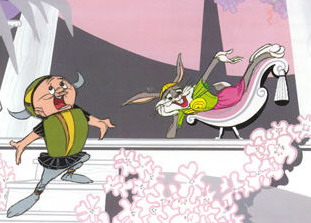'What's Opera, Doc?,' a cartoon that would likely never be made today, celebrates golden anniversary
At any other time, the film would not have been made. Imagine the pitch: “Let's steal time and funding from our other projects so we can go way over budget making a cartoon with no jokes, and no real gags. The score will be a German opera. Kids won't get it. Most adults won't get it, but I don't care because I think it's funny.”

Fortunately, the time was 1956, the director was Chuck Jones, and the place was the Warners Bros. backlot animation studio dubbed “Termite Terrace.” The result released 50 years ago this week was “What's Opera, Doc?,” voted by animators in the 1994 book The 50 Greatest Cartoons: As Selected by 1,000 Animation Professionals to be the greatest cartoon of all time.
It is the antithesis of the routine cartoon. In place of snappy one-liners we see Elmer Fudd and Bugs Bunny singing their parts with complete sincerity and commitment. The backgrounds are beautifully textured paintings. The score is powerful and moving. Bugs cuts a striking figure in a metallic brassiere before Madonna was even born. It's audacious and decadent and beautiful and bold and everything the vast majority of cartoons would never dare to be.
Years later, it was my immense pleasure to meet Chuck and spend several hours with him. Never before, and never since, have I encountered someone as smart, funny, passionate and wry, all rolled into one delightful and charming package. I can only imagine the magic at work as he and fellow geniuses Friz Freleng, Bob Clampett, Mike Maltese, Maurice Noble, Mel Blanc, Carl Stalling and a host of others created thousands (yes, thousands) of cartoons featuring history's greatest ensemble cast.
Chuck told me he and his team of writers and animators never saw themselves as making cartoons for anyone but themselves. Months, and sometimes years, passed before their work ended up in theatres, and by then they had made so many new cartoons public reaction just wasn't on their radar. It was because they made cartoons to humour themselves, and because studio executives didn't much care what they did so long as they stayed on time and on budget, that “What's Opera, Doc?” was possible.
The key was placing it between two Wile E. Coyote and Road Runner cartoons in the production schedule. Formulaic by design, those ones could be done fast and cheap. Knock off the Coyote films ahead of schedule and under budget, reallocate the time and money to “What's Opera, Doc?” so the overall budgets remained intact, and voila! A masterpiece created right under the noses of studio executives who would have vetoed the idea long before Elmer Fudd could have raised his spear and donned his magic helmet.
A few years ago, when I staged a tribute to Chuck and his incredible body of work, showing 15 of his greatest cartoons on the big screen as they were originally meant to be seen, it wasn't “What's Opera, Doc?” that got the biggest reaction, initially. The nearly 500 people in attendance gave their most enthusiastic reaction to the opening credits of “One Froggy Evening” featuring Michigan J. Frog, and “Rabbit of Seville,” the famous Bugs Bunny-Elmer Fudd barbershop ditty. Both great cartoons, to be sure, and both on any animation historian's top 10. The interesting thing was that for weeks afterward, people told me how moved they were by “What's Opera, Doc?” Some had never seen it before. Others had seen it on TV, but absent the big screen and big sound, they had failed to fall under its spell. Seeing it that day, the way audiences first saw it in 1957, they were enthralled.
That's what makes “What's Opera, Doc?” the greatest cartoon ever, and that is why a piece of such grandeur will never be repeated.
That's not to say good work hasn't been done in recent years. The laughs are plentiful with The Simpsons in its heyday, Family Guy most of the time, and South Park when they find that sweet spot between satire and absurdity. On the big screen, Pixar tells stories as captivating as the greatest Disney epics of the past, and pulls the viewer into spectacular and compelling worlds.
They are all great in their own way, but they are to be expected. Animated sitcoms are supposed to be funny and irreverent and mildly scandalous. Feature films are supposed to have rich character development, radio-worthy songs, and captivating storylines. Bugs Bunny cartoons are not supposed to feature a lisping Viking rabbit hunter enthusiastically professing his operatic love for a bunny in drag.
These days, cartoons are made for the small screen, for syndication, for licensing, for Happy Meal toys and theme park rides. Gone are the days when someone like Chuck could trick the system and go on a flight of fancy to animation immortality with such a hugely impractical and absolutely beautiful film.
No one who knows and loves “What's Opera, Doc?” will ever hear Wagner's “Der Ring des Nibelungen” without hearing, in their own minds, “Kill da wabbit . . . kill da wabbit.” While classical music aficionados may be offended by that fact, I'm okay with it. More than okay with it.
